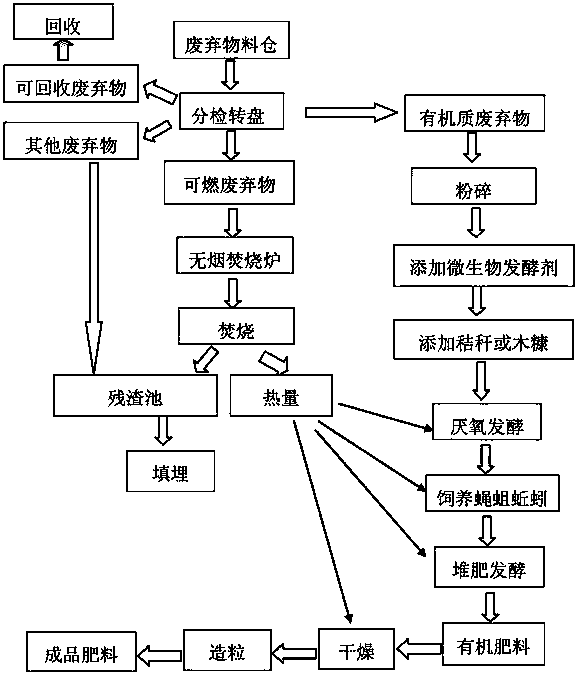Urban and rural waste treatment method
A treatment method and technology for waste, applied in the field of waste treatment and utilization, can solve the problems of expensive production costs, secondary pollution, deterioration of groundwater quality, etc., to reduce land occupation, work environment safety, and reduce secondary wastewater. Effect
- Summary
- Abstract
- Description
- Claims
- Application Information
AI Technical Summary
Problems solved by technology
Method used
Image
Examples
Embodiment 1
[0029] Sorting urban and rural wastes into recyclable wastes, combustible wastes, organic wastes, and other wastes on the sorting carousel, among which wastes that are both combustible and organic matter are classified as combustible wastes. Other waste refers to the waste left after removing recyclable waste, combustible waste and organic waste from urban and rural waste. The high-efficiency smokeless atmospheric pressure hot air and hot water dual-purpose garbage incinerators are connected with fermentation tanks, fly maggots and earthworm breeding rooms, and composting fermentation equipment to form a heating system. The combustible waste is incinerated by the garbage incinerator, and the heat generated can be supplied to the fermentation tank, fly maggot and earthworm breeding room, and composting fermentation equipment. Incineration products of combustible wastes and other wastes are thrown into the residue pool for landfill. After the organic waste is crushed to obtain ...
Embodiment 2
[0031] Sorting urban and rural wastes into recyclable wastes, combustible wastes, organic wastes, and other wastes on the sorting carousel, among which wastes that are both combustible and organic matter are classified as combustible wastes. Other waste refers to the waste left after removing recyclable waste, combustible waste and organic waste from urban and rural waste. The high-efficiency smokeless atmospheric pressure hot air and hot water dual-purpose garbage incinerators are connected with fermentation tanks, fly maggots and earthworm breeding rooms, and composting fermentation equipment to form a heating system. The combustible waste is incinerated by the garbage incinerator, and the heat generated can be supplied to the fermentation tank, fly maggot and earthworm breeding room, and composting fermentation equipment. Incineration products of combustible wastes and other wastes are thrown into the residue pool for landfill. After the organic waste is crushed to obtain ...
Embodiment 3
[0033]Sorting urban and rural wastes into recyclable wastes, combustible wastes, organic wastes, and other wastes on the sorting carousel, among which wastes that are both combustible and organic matter are classified as combustible wastes. Other waste refers to the waste left after removing recyclable waste, combustible waste and organic waste from urban and rural waste. The high-efficiency smokeless atmospheric pressure hot air and hot water dual-purpose garbage incinerators are connected with fermentation tanks, fly maggots and earthworm breeding rooms, and composting fermentation equipment to form a heating system. The combustible waste is incinerated by the garbage incinerator, and the heat generated can be supplied to the fermentation tank, fly maggot and earthworm breeding room, and composting fermentation equipment. Incineration products of combustible wastes and other wastes are thrown into the residue pool for landfill. After the organic waste is crushed to obtain t...
PUM
 Login to View More
Login to View More Abstract
Description
Claims
Application Information
 Login to View More
Login to View More - R&D
- Intellectual Property
- Life Sciences
- Materials
- Tech Scout
- Unparalleled Data Quality
- Higher Quality Content
- 60% Fewer Hallucinations
Browse by: Latest US Patents, China's latest patents, Technical Efficacy Thesaurus, Application Domain, Technology Topic, Popular Technical Reports.
© 2025 PatSnap. All rights reserved.Legal|Privacy policy|Modern Slavery Act Transparency Statement|Sitemap|About US| Contact US: help@patsnap.com

